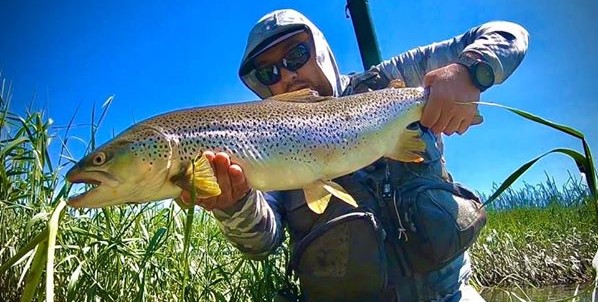The Bow River is a world-renowned trout sports fishery that is under considerable threat from the human population growth in the region, the ever-increasing demand for outdoor recreational pursuits, environmental changes, and degradation of aquatic and riparian habitat.
Fishery managers have monitored the Bow River for more than 30 years, and in this time, it has been demonstrated that up until 2003 the fishery was sustainable with the highest total trout populations of 1358/Km in 2000 and 1510 /Km in 2003. A size class analysis of the data showed trout populations of mature fish over 40 cm (16”) of 428/Km in 2000 and 617/Km in 2003(1).
A 2018 University of Calgary research paper (2) indicated that Bow River trout populations are in serious trouble. Data analysis showed that the Rainbow Trout population has declined by as much as 50% over ten years from 2003 to 2013. Although the reasons for the decline are unknown, the researchers have suggested that catch-and-release mortality, flood events, whirling disease, and angling pressure may well have contributed to the trout population decline. Because disease and floods are largely uncontrollable from a management perspective, the researchers suggest that stringent tactics such as angler restrictions may be necessary to stop the decline and hopefully enhance the sport fishery.
Alberta Environment & Parks (AEP) conducted fish population surveys across the entire sport fishery from Bearspaw Reservoir to Carseland Weir in 2018,2019 and 2020. That supports the previous research that the trout population has declined considerably over the past 20 years from their highs in 2000-2003. A detailed Cumulative Effect Model for the Bow River fishery is currently taking place to define what fishery management practices can be made to enhance the fishery.
In August 2020 Calgary River Users Alliance (CRUA) expressed our concern about the impact of Bow River water management policy on the fish populations to the AEP Water Policy Branch. After extensive discussions, the Alberta Environment & Parks (AEP) Fish and Wildlife Policy Branch was brought into the conversation to form the current AEP-CRUA Joint Technical Liaison Group to define ways to cooperatively advance discussions to develop both water and fishery management policy to improve the Bow River sports fishery
The scope of the AEP-CRUA Joint Technical Liaison Group:
- A Scientific Assessment of Fish Population Declines:The recent Bow River Fish Population Survey from 2018-20 and the Angling Effort Survey from 2018 are important steps that have been taken to update the knowledge database of fish population dynamics. And when combined with water management protocols into a cumulative effect modeling framework will hopefully guide fishery management directives.
- Short-Term Water Flow Management Change:The modified Bow River water management policy that has been in place since 2014 and renewed for a further five years in 2021 has created some degree of frustration within the fishing community. Certainly, flood protection for the City of Calgary is important, but rapid change in daily flows needs to be eliminated outside of emergency intervention to protect infrastructure and protect the ecology of the river.
- Bow Basin Future Water Management Policy:The Bow Basin Water Management Options to improve flood and drought protection will no doubt be controversial, especially any new dam additions in the future. Although there is a need for an environmental assessment, the scope of what has been completed to date has not taken into account the impact on the wild-non-native trout population in the Bow River.Should peak-hydro electrical power generation be phased out in the future? The Kananaskis River native cutthroat and bull trout fishery downstream of the Pocaterra Power Plant has been devastated by peak-hydro operations. The Bow River between Ghost and Bearspaw reservoirs is similar. Both these fisheries have the potential to absorb the ever-increasing angling pressure within the Bow Basin if water management and hydro operations were changed.
Update of the AEP-CRUA Joint Technical Liaison Group:
A review of the AEP-CRUA Joint Technical Liaison Group and the Bow River Cumulative Effect Science Team report(3) is available at the following CRUA web link.
It will take time for the rollout of water and fishery management changes to enhance the Bow River fishery, but CRUA and our affiliated organization are confident changes in policy are forthcoming.
References:
- Bow River Trout Populations Could Well Be in Decline -A Need For A Change In Fishery Management. Bow River Trout Foundation. 2018. https://bowrivertrout.files.wordpress.com/2018/06/bowriverfishpopulations-report06june20182.pdf
- Multiple challenges confront a high-effort inland recreational fishery in decline. Christopher L. Cahill, et al. https://docs.wixstatic.com/ugd/c9e0c9_c5a407800c1a4425b91c80b9f2ac8eff.pdf
- The Impact of Bow River Water Management Policy on Fish Populations – Update April 2021. Calgary River Users Alliance https://www.calgaryriverusers.org/wp-content/uploads/2021/04/Bow-River-Fishery-Update-April-2021-Public-Doc.pdf
April 16, 2021
